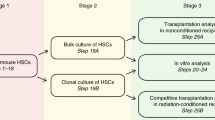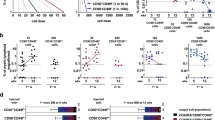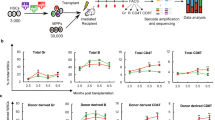Abstract
The composition of the human hematopoietic stem cell compartment is poorly understood due to the absence of experimental tools with which to characterize the developmental program of individual stem cells. We report here that human stem cells differ markedly in their repopulation capacity and self-renewal potential, as determined using nonobese diabetic–severe combined immunodeficiency (NOD-SCID) mice transplanted with retrovirally transduced cord blood stem cells, called SCID-repopulating cells (SRCs). Clonal stem cell analysis based on the identification of unique retroviral integration sites within serial bone marrow aspirates showed that repopulation was generally oligoclonal with extensive variability in the lifespan and proliferative capacity of individual SRCs. Most clones contributed to human cell engraftment for several weeks after transplantation and then disappeared but others appeared later and persisted. Further evidence for stem cell heterogeneity was found in the secondary transplantation capacity of SRCs. These data point to the existence of different classes of human stem cells with variable self-renewal potential and short- or long-term repopulating capacity.
This is a preview of subscription content, access via your institution
Access options
Subscribe to this journal
Receive 12 print issues and online access
$209.00 per year
only $17.42 per issue
Buy this article
- Purchase on Springer Link
- Instant access to full article PDF
Prices may be subject to local taxes which are calculated during checkout







Similar content being viewed by others
References
Dick, J. E. Normal and leukemic human stem cells assayed in SCID mice. Semin. Immunol. 8, 197–206 ( 1996).
Kamel-Reid, S. & Dick, J. E. Engraftment of immune-deficient mice with human hematopoietic stem cells. Science 242 , 1706–1709 (1988).
Lapidot, T. et al. Cytokine stimulation of multilineage hematopoiesis from immature human cells engrafted in SCID mice. Science 255, 1137–1141 (1992).
Larochelle, A. et al. Identification of primitive human hematopoietic cells capable of repopulating NOD/SCID mouse bone marrow: implications for gene therapy . Nature Med. 2, 1329–1337 (1996).
Wang, J. C., Doedens, M. & Dick, J. E. Primitive human hematopoietic cells are enriched in cord blood compared with adult bone marrow or mobilized peripheral blood as measured by the quantitative in vivo SCID-repopulating cell assay. Blood 89, 3919–3924 ( 1997).
Bhatia, M., Wang, J. C. Y., Kapp, U., Bonnet, D. & Dick, J. E. Purification of primitive human hematopoietic cells capable of repopulating immune-deficient mice. Proc. Natl Acad. Sci. USA 94, 5320–5325 ( 1997).
Bhatia, M. et al. Quantitative analysis reveals expansion of human hematopoietic repopulating cells after short-term ex vivo culture. J. Exp. Med. 186, 619–624 ( 1997).
Bhatia, M., Bonnet, D., Murdoch, B., Gan, O. I. & Dick, J. E. A newly discovered class of human hematopoietic cells with SCID- repopulating activity. Nature Med. 4, 1038–1045 (1998).
Dick, J. E., Magli, M. C., Huszar, D., Phillips, R. A. & Bernstein, A. Introduction of a selectable gene into primitive stem cells capable of long-term reconstitution of the hemopoietic system of W/Wv mice. Cell 42, 71–79 (1985).
Keller, G., Paige, C., Gilboa, E. & Wagner, E. F. Expression of a foreign gene in myeloid and lymphoid cells derived from multipotent haematopoietic precursors. Nature 318, 149– 154 (1985).
Lemischka, I. R., Raulet, D. H. & Mulligan, R. C. Developmental potential and dynamic behavior of hematopoietic stem cells. Cell 45, 917– 927 (1986).
Snodgrass, R. & Keller, G. Clonal fluctuation within the haematopoietic system of mice reconstituted with retrovirus-infected stem cells. EMBO J. 6, 3955–3960 ( 1987).
Jordan, C. T. & Lemischka, I. R. Clonal and systemic analysis of long-term hematopoiesis in the mouse. Genes Dev. 4, 220–232 (1990).
Zijlmans, J. M. et al. Modification of rhodamine staining allows identification of hematopoietic stem cells with preferential short-term or long-term bone marrow-repopulating ability. Proc. Natl Acad. Sci. USA 92, 8901 –8905 (1995).
Osawa, M., Hanada, K., Hamada, H. & Nakauchi, H. Long-term lymphohematopoietic reconstitution by a single CD34− low/negative hematopoietic stem cell. Science 273, 242– 245 (1996).
Morrison, S. J., Wandycz, A. M., Hemmati, H. D., Wright, D. E. & Weissman, I. L. Identification of a lineage of multipotent hematopoietic progenitors. Development 124, 1929–1939 (1997).
Abkowitz, J. L. et al. Behavior of hematopoietic stem cells in a large animal. Proc. Natl Acad. Sci. USA 92, 2031– 2035 (1995).
Kim, H. J. et al. Many multipotential gene-marked progenitor or stem cell clones contribute to hematopoiesis in nonhuman primates. Blood 96, 1–8 (2000).
Drize, N. J., Keller, J. R. & Chertkov, J. L. Local clonal analysis of the hematopoietic system shows that multiple small short-living clones maintain life-long hematopoiesis in reconstituted mice. Blood 88, 2927– 2938 (1996).
Drize, N., Chertkov, J., Sadovnikova, E., Tiessen, S. & Zander, A. Long-term maintenance of hematopoiesis in irradiated mice by retrovirally transduced peripheral blood stem cells . Blood 89, 1811–1817 (1997).
Brenner, M. K. et al. Gene marking to determine whether autologous marrow infusion restores long-term haemopoiesis in cancer patients. Lancet 342, 1134–1137 (1993).
Kohn, D. B. et al. Engraftment of gene-modified umbilical cord blood cells in neonates with adenosine deaminase deficiency. Nature Med. 1, 1017–1023 (1995).
Deisseroth, A. B. et al. Genetic marking shows that Ph+ cells present in autologous transplants of chronic myelogenous leukemia (CML) contribute to relapse after autologous bone marrow in CML. Blood 83, 3068–3076 (1994).
Dunbar, C. E. et al. Retrovirally marked CD34-enriched peripheral blood and bone marrow cells contribute to long-term engraftment after autologous transplantation . Blood 85, 3048–3057 (1995).
Hanenberg, H. et al. Optimization of fibronectin-assisted retroviral gene transfer into human CD34+ hematopoietic cells. Hum. Gene Ther. 8, 2193–206 ( 1997).
Conneally, E., Eaves, C. J. & Humphries, R. K. Efficient retroviral-mediated gene transfer to human cord blood stem cells with invivo repopulating potential. Blood 91, 3487–3493 ( 1998).
Marandin, A. et al. Retrovirus-mediated gene transfer into human CD34+38low primitive cells capable of reconstituting long-term cultures in vitro and nonobese diabetic-severe combined immunodeficiency mice in vivo. Hum. Gene Ther. 9, 1497–511 (1998).
Schilz, A. J. et al. High efficiency gene transfer to human hematopoietic SCID-repopulating cells under serum-free conditions. Blood 92, 3163–3171 (1998).
van Hennik, P. B. et al. Highly efficient transduction of the green fluorescent protein gene in human umbilical cord blood stem cells capable of cobblestone formation in long-term cultures and multilineage engraftment of immunodeficient Mice . Blood 92, 4013–4022 (1998).
Rebel, V. I. et al. One-day ex vivo culture allows effective gene transfer into human nonobese diabetic/severe combined immune-deficient repopulating cells using high-titer vesicular stomatitis virus G protein pseudotyped retrovirus . Blood 93, 2217–2224 (1999).
Barquinero, J. et al. Efficient transduction of human hematopoietic repopulating cells generating stable engraftment of transgene-expressing cells in NOD/SCID mice. Blood 95, 3085–3093 (2000).
Dorrell, C., Gan, O. I., Pereira, D. S., Hawley, R. G. & Dick, J. E. Expansion of human cord blood CD34+CD38− cells in ex vivo culture during retroviral transduction without a corresponding increase in SCID Repopulating Cell (SRC) frequency: dissociation of SRC phenotype and function. Blood 95, 102–110 ( 2000).
Gan, O. I. et al. Characterization and retroviral transduction of an early human lymphomyeloid precursor assayed in nonswitched long-term culture on murine stroma. Exp. Hematol. 27, 1097– 1106 (1999).
Abonour, R. et al. Efficient retrovirus-mediated transfer of the multidrug resistance 1 gene into autologous human long-term repopulating hematopoietic stem cells . Nature Med. 6, 652–658 (2000).
Peled, A. et al. Dependence of human stem cell engraftment and repopulation of NOD/SCID mice on CXCR4. Science 283, 845 –848 (1999).
Abkowitz, J. L., Golinelli, D., Harrison, D. E. & Guttorp, P. In vivo kinetics of murine hemopoietic stem cells. Blood 96, 3399–3405 (2000).
Guenechea, G. et al. Transduction of human CD34+ CD38− bone marrow and cord blood-derived SCID-repopulating cells with third-generation lentiviral vectors. Mol. Ther. 1, 566– 573 (2000).
Nolta, J. A., Dao, M. A., Wells, S., Smogorzewska, E. M. & Kohn, D. B. Transduction of pluripotent human hematopoietic stem cells demonstrated by clonal analysis after engraftment in immune-deficient mice. Proc. Natl Acad. Sci. USA 93, 2414 –2419 (1996).
Cheng, L. et al. A GFP reporter system to assess gene transfer and expression in human hematopoietic progenitor cells. Gene Ther. 4, 1013–1022 (1997).
Wang, Y. et al. Leptin receptor action in hepatic cells. J. Biol. Chem. 272, 16216–16223 ( 1997).
Pereira, D. S. et al. Retroviral transduction of TLS-ERG initiates a leukemogenic program in normal human hematopoietic cells. Proc. Natl Acad. Sci. USA 95, 8239–8244 ( 1998).
Vormoor, J. et al. Immature human cord blood progenitors engraft and proliferate to high levels in severe combined immunodeficient mice. Blood 83, 2489–2497 (1994).
Guenechea, G. et al. Delayed engraftment of nonobese diabetic/severe combined immunodeficient mice transplanted with ex vivo-expanded human CD34(+) cord blood cells . Blood 93, 1097–1105 (1999).
Ferda Percin, E. et al. Human microphthalmia associated with mutations in the retinal homeobox gene CHX10. Nature Genet. 25, 397 –401 (2000).
Limon, A. et al. High-titer retroviral vectors containing the enhanced green fluorescent protein gene for efficient expression in hematopoietic cells. Blood 90, 3316–3321 ( 1997).
Acknowledgements
We thank C. Botsford for the CB samples, G. Knowles for flow sorting of MGIN cells, R. G. Hawley and T. Hawley for the PG13-MGIN producer cell line, R. McInnes for the primers and template required for human chx10 sequence amplification and J. Ellis and R. McInnes for critical review of the manuscript. Supported by grants from the National Cancer Institute of Canada with funds from the Canadian Cancer Society, the Canadian Genetic Diseases Network of the National Centers of Excellence (to J. E. D.), the Medical Research Council (to J. E. D.), a Medical Research Council Scientist award (to J. E. D.) and the Comisión Interministerial de Ciencia y Tecnología (to G. G., grant number SAF9808C04-1).
Author information
Authors and Affiliations
Corresponding author
Rights and permissions
About this article
Cite this article
Guenechea, G., Gan, O., Dorrell, C. et al. Distinct classes of human stem cells that differ in proliferative and self-renewal potential. Nat Immunol 2, 75–82 (2001). https://doi.org/10.1038/83199
Received:
Accepted:
Issue Date:
DOI: https://doi.org/10.1038/83199
This article is cited by
-
The universal stem cell
Leukemia (2022)
-
Cancer stem cell transcriptome landscape reveals biomarkers driving breast carcinoma heterogeneity
Breast Cancer Research and Treatment (2021)
-
PTK7 promotes the malignant properties of cancer stem-like cells in esophageal squamous cell lines
Human Cell (2020)
-
One or two umbilical cord blood cell units? Caveat emptor
Bone Marrow Transplantation (2017)
-
Lung as a Niche for Hematopoietic Progenitors
Stem Cell Reviews and Reports (2017)



